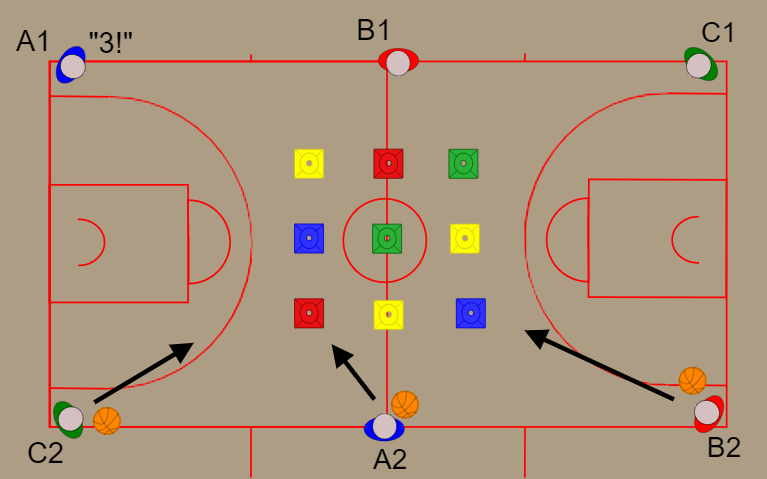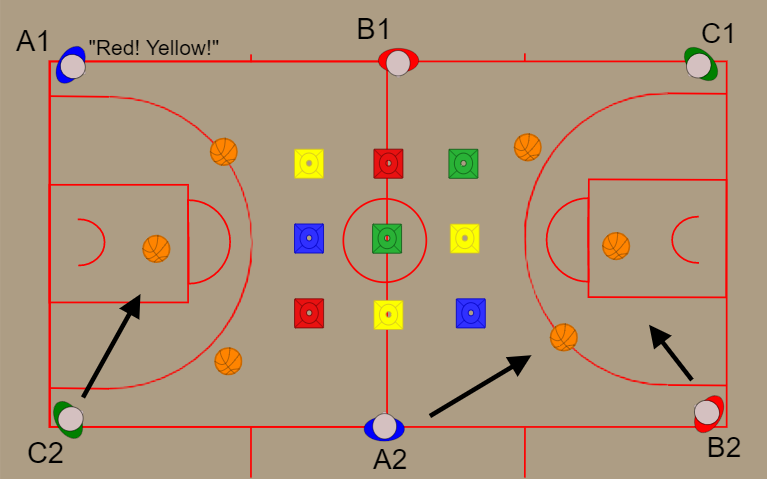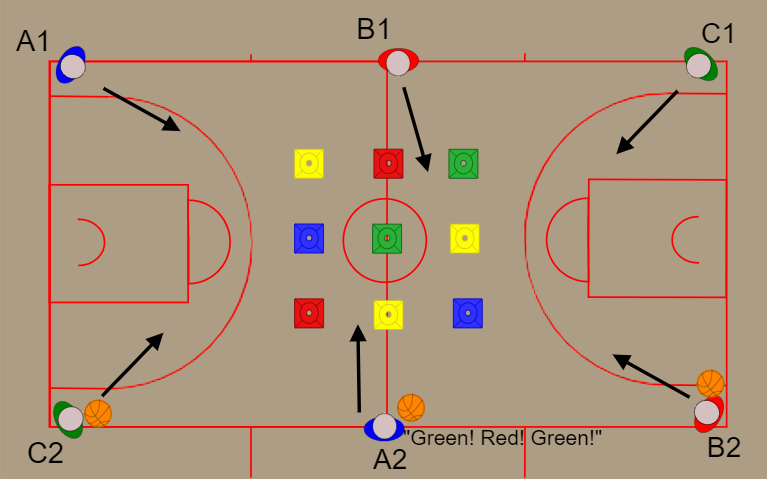EXPLANATION OF THE ROUTINE:
The routine consists of varies fundamental movement skills, such as changing direction and agility. In this routine the players are going to run, tap cones, attack or defend the basket within three different levels. Players are going to score a given number of points after passing through a cone area while performing cutting movements. You can use more cones when you have more players.
PREPARATION
- 9 cones in a square 3×3 cones, 3 different colors
- Place 9 cones (3 red, 3 blue, 3 yellow) around the court.
- Place at least 3 balls randomly around the court (safety position: e.g. not under the basket).
EXECUTION OF THE ROUTINE:
In this routine, the primary context is a basketball court where basketball coaches regularly perform the practice sessions at a club. The routine can be used as warming-up for different types of goals in basketball (i.e. make space dribbling, fake movements, defending, attacking, scoring, etc.) or as a core routine in a training session.
ADDITIONAL INFORMATION: HOW DO WE REACH OPTIMAL MOTOR LEARNING AND APPLY SELF-DETERMINATION?
- Decision making will stimulate adaptive motor control: Multidirectional skills in an open unpredictable environment are incorporated, defender/attackers must anticipate/react depending on quick changes in the environment (e.g. other players, cone color change, ball)
- Implicit motor learning: This is stimulated with the external focus / analogy examples of instructions/feedback to improve body posture while changing directions.
- Challenge/Fun: Beating the opponent (challenge) to collect a winning point (fun/gamification). This means agility/changing direction is practiced with some pressure (i.e. time pressure or earning points, making space smaller creates a challenge).
- Motivation: Enhanced by providing autonomy and replicating various realistic in game situations (tasks, goals, scores, defender/attacker) stimulating a safe challenge between players (e.g.: give a point when successfully defended will increase the competition between players).
- Autonomy: Make the players choose or control different aspect of the play (e.g.: role attacker/defender, which sequence of cone to be tapped, practice with or without a ball, etc.).
- Competence: Feeling of competence is created by giving the player option to choose a variation of the routine (by means of level or material).
- Relatedness: Feeling of relatedness is created by the sport specificity with their peers + by feeling most related by which option they have chosen from.
- Differentiation (age/difficulty): the routine is made in order to be easily adapted by the coach for various players ‘needs.
POSSIBLE VARIATIONS
-
Make ‘moving optimally’ a game. That means players can get points by cutting correctly (in terms of cutting technique for the prevention goal – coach will observe).
-
Adding time pressure: whoever/which team scores most goals (point) within that time?
Use the colors of the cones with the analogy of traffic light (red/yellow/green or green/yellow/red)=> coach or player shouts a colour and so decides the order to touch cones (if red first then green then yellow; if green first then yellow then red; if yellow first then red and then green). -
Changing speed of the routine based on the color (green/run + red/walk
-
Do it the same with numbers (put numbers on the cones or set up lines)
E.g. coach or player shouts a number => 132 (working memory) or shouts 1 then 3 then 2 (reactive play)). -
Play with a blue team and red team (e.g. when you have 5 players per team you need to have 15 cones of the same color). If a cone is blocked a player from the same color is blocked too and has to leave the area, score and come back to the area.
-
Use blue/red cones => fire/water => x/o principles => the cone on top blocks the cone on the bottom => the purpose is to block at least 3 opponent cones.
If two cones of the same color are put together, they are “immune” and they cannot be blocked. As soon as the player moves the cone, he then quickly moves towards the basket and tries to score. Each player can move just one cone at a time. As soon as all cones are blocked or saved the players left go to the basket and try to score. -
Use different balls (players can choose from e.g. a basketball, handball, tennisball).
- You could set up the routine without the balls and dribbling for a jump-shot. You can make a variation of the task by adding rings or tennis ball that have to be carried from one colour cone to another cone of the same colour.
- The player who finishes the task can shout the colour that needs to touched by the next set of players.
- Initially 6 players (A1, A2, A3) on one side and (B1, B2, B3) on different side are ready to perform the exercise.
- As soon as the players (A1, A2, A3) start moving with no ball towards the cones, player B1 shouts the colour of the cone that needs to be touched first. Then player B2 shouts the colour and then player B3 shouts the colour. Players should be advised when to shout the colour (for example when all 3 players have touched colour, when first players touched the respective colour cone).
- After all cones are touched, each player (A1, A2, A3) can collect a ball autonomously around the court. After this, the players with the ball, can dribble to the basket and perform a jump-shot.
- After jumpshot is made (A1, A2, A3) players collect the rebound and dribble to exercise area. Whoever comes first shouts the colour for players B1, B2, B3 to be touched, then the second player who comes back after jumpshot shouts the colour, then third.
- After B1, B2, B3 have touched the 3 shouted colour cones they can collect the ball and dribble to the basket.
- The game ends for example when a player has made five successful jump-shots. Then B1 will have the power to choose the order of the cones to be touched and we can start again the routine.
- Players performing the task (A1, A2, A3) have balls from the beginning (balls are no more placed around the court).
- The sequence of shout colour is the same as intermediate
- Players entering the cone zone, have to dribble the ball and tap different colour cones while dribbling the ball.
- After all cones are touched, the player can dribble to the basket and perform a jumps After jumpshot is made, the player comes back to the cone area and passes the ball to player of his choice (B1, B2, B3) and shouts the colour of the cones that need to touched.



